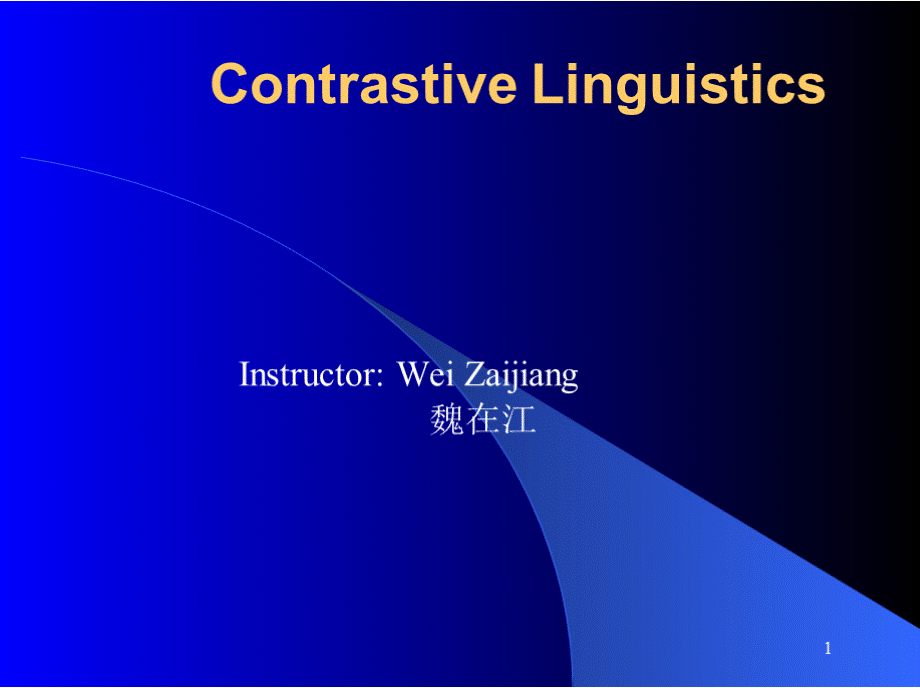Unit-1-Contrastive-Linguistics英文PPT课件讲解.pptx
《Unit-1-Contrastive-Linguistics英文PPT课件讲解.pptx》由会员分享,可在线阅读,更多相关《Unit-1-Contrastive-Linguistics英文PPT课件讲解.pptx(78页珍藏版)》请在冰点文库上搜索。

ContrastiveLinguistics,1,Instructor:
WeiZaijiang魏在江,WeiZai-jiang魏在江Tel:
029-85309400(o)西安外国语大学学报编辑部E-mail:
2,Content,3,Anintroductiontocontrastivelinguisticsincludesdefinitions;backgroundtheinfluenceoflinguistics,philosophy,sociologyandsociolinguisticsonthedevelopmentofcontrastivelinguistics,andcentralconcepts-.etc.,Anexaminationoftheanalyticalframeworksingrammar,vocabulary,pragmaticandtextualcontrastivestudieswillbediscussedindetails.ThediscussionalsocoversimplicationsofcontrastivelinguisticsinESPtextstudies,EFLteaching,Translationstudiesandliteraturestudies.,4,Approach,5,Themodulewillcombinelectureswithpracticalactivityanddiscussion.Participantswillbeexpectedtodoaconsiderableamountofpracticalworkonthelocaltextsduringthemodule.Themodulewillbeassessedintermsofassignment.,Syllabus,6,Unit1:
GeneralintroductionUnit2:
PrinciplesandProceduresUnit3:
Phonetic&PhonologicalContrastiveStudiesUnit4:
LexicalContrastiveAnalysisUnit5:
GrammaticalContrastiveAnalysisUnit6:
PragmaticContrastivestudiesUnit7:
TextualContrastiveAnalysis,Unit8:
CognitivelinguisticsandContrastivelinguisticsUnit9:
CulturaldifferencesinEnglishandChineseUnit10:
ContrastiveLinguisticsandtranslationUnit11:
contrastivelinguisticsandForeignlanguageteachingUnit12:
corpuslinguisticsandcontrastivelinguistics,7,Workshopsandseminars:
8,1.Casestudies:
textanalysis2.Casestudies:
problemsinforeignlanguageteachingandtranslation,Basicreading:
9,AndrewChesterman.ContrastiveFunctionalAnalysis.JohnBenjamins.1998Brown,G.&YuleG.DiscourseAnalysis.CUP.1983CarlJames.ContrastiveAnalysis.Longman.1980Keping.ContrastiveLinguistics.NanjingNormalUniversity.1999,M.A.K.HallidayandRuqaiyaHasan.CohesioninEnglish.1976RobertLado.LinguisticsAcrosscultures.TheUniversityofMichiganPress.957Saussure.TheCourseofGeneralLinguistics.Beijing:
ForeignLanguageteachingandResearchPress.2002TomaszP.Krzeszowski.ContrastingLanguages-TheScopeofContrastiveLinguistics.,10,MoutonDeGruyter.1990许余龙对比语言学上海外语教育出版社2002年版(研究生教材)陈治安、刘家荣、文旭.英汉对比语用学与外语教学.北京:
外语教学与研究出版社.2003高远.对比分析与错误分析.北京航空航天大学出版社.2002潘文国.汉英语对比纲要.北京语言文化大学出版社.2003,11,杨自俭.英汉对比研究论文集.上海外语教育出版社.1994杨自俭.英汉比较与翻译(3,4,5).上海外语教育出版社喻荣根.英汉对比语言学.北京工业大学出版社.1989何善芬.英汉语言对比研究.上海外语教育出版社.2002,12,李瑞华.英汉语言与文化对比研究.上海外语教育出版社.1998连叔能.英汉对比研究.高等教育出版社.1994邵志洪.英汉语研究与对比.华东理工大学出版社.1997杨自俭.英汉比较与翻译(3,4,5).上海外语教育出版社喻荣根.英汉对比语言学.北京工业大学出版社.1989杨自俭.英汉比较与翻译(3,4,5).上海外语教育出版社,13,Unit1Introduction,14,1.1WhatisContrastiveLinguistics?
Whenwetakeupanysubjectforstudy,weusuallystartbyinvestigatingitsnature,itsrelevancetous,andthewaytostudyit.Inotherwords,weaskthreebasicquestions:
whatitis,(b)whyitisneededorimportant,and(c)howtodoit.Inthissectionweshalltrytoanswerthesethreebasicquestionsaboutcontrastivelinguistics.,1.1.1NameandNature,15,Apparentlycontrastivelinguistics,issomethingrelatedtoorincludedunderlinguistics.Soletus,asthesayinggoes,beginfromtheverybeginningandexaminationofthenameandnatureoflinguistics.,Linguistics,16,Languageisusedbyuseveryday.Itisareality,thatis,itissomethingactuallyorexperiencedbyus.Generallyspeaking,wemaydistinguishthreeaspectsofreality,physical,social,andpsychological-.,andatleastfivemodesoforapproachestoknowingreality,thatis,philosophical,mathematical,theological,humanistic,andscientific.Variousdisciplines,inlightoftheaspectsofrealitytheyareinterestedin,approachtheirsubjectmatterlargelyfromthepointofviewofoneofthesefivemodes,17,Wemayconsiderthefollowingfactsaboutlanguageandapproachestotherealityoflanguagebeforewecometocharacterizethenatureoflinguistics.
(1)Languageissociallyacquiredandused.Asasocialphenomenon,itobviouslyhassocialreality.,18,
(1)Ashumanbehavior,languagehaspsychologicalreality.Twomajorlinguisticschoolsinthe20thcenturyhavebeenstructurallinguisticsandgenerativelinguistics.Bothofthemanalyzelanguageintermsofhumanbehavior(thatis,verbalbehavior”_structurallinguistSkinnerwroteabookinthisverytitle.”
(2)Philosophical,mathematicalandtheologicalapproachestotherealityoflanguageareevidentlyrelevantonlyinratherlimitedways.,19,
(1)Neitherisahumanisticapproachofmuchusetothelinguists.Thehumanisticapproachlaysemphasisontheindividualcharacteristics.Thetypicalmethoditemploysiscalledverstechen(understandfromwithin).Whatisleft,then,isthescientificapproach.Linguisticsclaimstobeanempiricalscienceandassuchitaimsattrue(inthesenseofverifiableandfalsifiable)statementsbymeansofformulatingtestablehypotheses.,20,
(1)Basedontheanalysismadeaboveofthefeaturesoflanguageandtherelevantapproachestoit,wemaydepictthenatureoflinguisticsasfollows:
Linguisticsisascientificstudyoflanguage,whichexistsmainlyassocialandpsychologicalrealities.,21,1.1.1.2ContrastiveLinguistics,22,What,then,iscontrastivelinguistics?
Apparently,contrastivelinguisticsisakindoforabranchoflinguistics.Asitsnamesuggests,contrastivelinguisticsinvolvescontrastorcomparison.Comparisonisoneofthebasicwaysbywhichwestudyobjectsandgettoknowthem,justasthesayinggoes,?
onlybycomparisoncanonedistinguish.”Themethodofcomparisoniswidelyusedinlinguistics.,Almostallthebranchesoflinguisticsinvolvecomparisonofonekindoranother,sincetoidentifyandelaborateonaparticularfeatureofthehumanlanguage,linguistsusuallyhavetomakeanexplicitorimplicitcomparativeorcontrastiveanalysisofthevariousformsinwhichthefeaturefindsexpressionandtheparallelsoftheseformsinsomerelatedsystems.,23,Wemaycometoabetterunderstandingofthenatureofcontrastivelinguisticsbyputtingitintheperspectiveofageneralframeworkofcomparisonsandbetweenlanguages.Comparisonmaybeconductedintralinguallyorinterlinguallyonasynchronicbasisoronadiachronicbasis.Sofourtypesofcomparisonmaybedistinguished:
24,
(1)Synchronicintralingualcomparison.Thisisthecomparisonoftheconstituentformsofthephonetic,phonological,lexical,grammaticalandotherlinguisticsystemswithinaparticularlanguageduringaspecificperiodofitsevolution.,25,
(2)Diachronicintralingualcomparison.,26,Thiskindofcomparisonoccurswherethehistoryofagivenlanguageisinvolved.AdiachroniccomparisonofEnglish,forinstance,revealsthatthelanguagehasundergonefourstagesofevolvement:
OldEnglish(upto1150),MiddleEnglish(1150-1500),EarlyEnglish(1500-1700)andLateModernEnglish(1700onwards),withitsgrammarbecomingincreasinglyanalytic,thatis,thenumberofinflectedwordendingsdrasticallydecreasedandgrammaticalmeaningsareincreasinglyexpressedbywordorderandfunctionwordssuchasprepositions.Diachronicintralingualcomparisonistheprincipalmethodemployedbytheresearchersoflanguagehistory,etymologyandotherrelatedbranchesoflinguisticstudy.,27,(3)Diachronicinterlingualcomparison.Whencomparisoncrosseslanguageborders,wegetaveryimportantbranchoflinguisticsthatdevelopedinmoderntimes.Thisistheso-called(comparative)historiclinguistics(alsoknownasphilologywhichstatedinthelate18thcenturyandevolvedintoadominantbranchoflinguisticstudyinthe19thcentury.,28,4)Synchronicinterlingualcomparison.Accordingtothepurposeofcomparison,threekindsofitmaybedistinguished:
(a)thefirstkindofsynchronicinterlingualcomparisoniscarriedoutwithaviewtofindingoutthecommonfeaturesofandthelawsgoverningthestructuresofallthelanguagesintheworld.Itsgoal,inotherwords,istofindoutthe“languageuniversals”or“linguisticuniversals”.,29,ThisissomethingwhichgenerativeschoolsoflinguisticsheadedbyTransformationalgrammarhavebeenendeavoringtodo(b)Thesecondkindofsynchronicinterlingualcomparisonisconductedfortheaimoffindingoutthetypicaldifferencesbetweenallthelanguagesintheworldintheirstructuresothattheselanguagescanbeclassifiedaccordingtotheirformalfeatures.,30,(c)Thethirdkindofsynchronicinterlingualcomparisonisconductedwithinthescopeofusuallytwolanguages,althoughmorelanguagesmaybeinvolved.Theaimofthiskindofcomparisonistofindoutthediscrepanciesand,toalesserdegree,thesimilaritiesinthestructuresofthelanguagesbeingcompared.Thisisexactlywhatcontrastivelinguisticsundertakestodo(Xu,1992:
3-4),31,Wemaythencharacterizecontrastivelinguisticsinthefollowingway:
Contrastivelinguisticsisabranchoflinguisticswhichstudiestwoormorelanguagessynchronically,withtheaimsofdiscoveringtheirdifferencesandsimilarities(especiallytheformer)andapplyingthesefindingstorelatedareasofstudy.,32,Contrastivelinguisticsisalsoknownas“contrastiveanalysis”(CA)or“contrastivestudies”.Thesethreetermsarelargelyinterchangeable.,33,1.1.1Classification,34,Havingidentifiedthenatureofcontrastivelinguisticsaswellasthestatusitkeepsinthebroadareaoflanguagestudies,itisappropriatenowforustotakealookatthemake-upofthisbranchoflinguistics.Wemayclassifycontrastivelinguisticsalongtwoaxes,i.e.theoreticalvspractical,andmicrolinguisticsvs.macrolinguistics,Thisapproach,called:
linguistictypology”,hasestablishedaclassificatorysystemforthelanguagesoftheworldintowhichindividuallanguagescanbeslottedaccordingtotheirpreferredgrammaticaldevices:
sonowwecantalkabout“synthetic”,”analytic”,”inflectional,“agglutinating”and“tone”,language,35,1.1.2.2TheoreticalandApplied,36,ContrastiveLinguistics,Theoreticalcontrastivelinguisticstriestofindsuitablemodelsandtheoreticalframeworksforcomparisonandtoestablishsuchkeynotionsascongruen